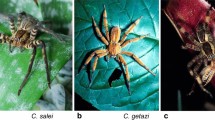Summary
When the wandering spiderCupiennius salei is standing with one or several of its legs on a platform that begins to vibrate, it turns toward the platform if the stimulus resembles prey-generated vibration. With application of simultaneous, uniformly intense substrate vibration, the turning angle depends on the combination of legs stimulated.
When the forelegs are stimulated the mean error angle is smaller than when the stimulus is applied to the hindlegs (Figs. 3, 4a, 6, 7); accordingly, the sensory information from the forelegs is weighted more strongly in establishing turning angle. The relation of turning angle to the stimulated leg combination can be described by the following three properties of the central nervous interaction of the sensory inputs from the eight legs. 1. The stimulus angles are multiplied by aconstant weighting factor (F) specific to each leg (1st leg,F=1.2; 2nd leg, 0.6; 3rd and 4th legs, 0.4). 2. The stimulation of an anterior leg reduces theF of all posterior legs on the same side by 0.1 (additiveipsilateral inhibition). 3. When legs are stimulated on both sides there is a reciprocalcontralateral inhibition acting exclusively from front to back. This inhibition is multiplicative, in all cases decreasingF by the factor 0.5.
During experiments in which stimuli with different amplitudes(p 1∶p 2=1∶3.3) or onset times (Δt = 4 ms) are produced by two vibrators, the spiders always move in the direction of the legs stimulated first or with larger amplitude (Figs. 5, 6, 7), as though only these legs were stimulated.
The turning angles resulting from airborne stimulation alone (buzzing fly) or substrate vibration alone (vibrating platform, trichobothria removed) do not differ significantly from those found with simultaneous stimulation by way of both air and substrate (P>0.05, F-test). They are distinctly smaller than the stimulus angles. The error angles increase as the stimulus site moves further posterior (Figs. 2, 8). Asymmetrical removal of trichobothria (only the 3rd and 4th right legs intact) reveals that these receptors interact in the CNS with the substrate-vibration receptors: when stimluated by way of the substrate and the air together (buzzing fly between the intact legs) the animals turn further (in the direction of the intact legs) than do animals entirely lacking trichobothria (Figs. 5a, 6, 7).
Similar content being viewed by others
References
Barth FG (1982) Spiders and vibratory signals: sensory reception and behavioral significance, chap. 3. In: Witt P, Rovner JS (eds) Spider communication, mechanisms and ecological significance. Princeton Univ Press, Princeton NJ, pp 67–122
Barth FG, Seyfarth EA (1979)Cupiennius salei Keys, in the highlands of central Guatemala. J Arachnol 7:255–263
Batschelet E (1965) Statistical methods for the analysis of problems in animal orientation and certain biological rhythms. Am Inst Biol Sci, Washington
Bleckmann H (1982) Die Reaktion der RaubspinneDolomedes triton auf Oberflächenwellen des Wassers. Verh Dtsch Zool Ges 75:253
Brownell PH, Parley R (1979) Orientation to vibrations in sand by the nocturnal scorpionParuroctonus mesaensis: mechanism of target localization. J Comp Physiol 131:31–38
Hergenröder R, Barth FG (1982) Die Auslösung von Beutefangverhalten bei der JagdspinneCupiennius salei durch Vibrationen der Unterlage. Verh Dtsch Zool Ges 75:252
Hergenröder R, Barth FG (1983) The release of attack and escape behavior by vibratory stimuli in a wandering spider (Cupiennius salei Keys.). J Comp Physiol 152:347–359
Klärner D, Barth FG (1982) Vibratory signals and prey capture in web spiders (Zygiella x-notata, Nephila clavipes). J Comp Physiol 148:445–455
Melchers M (1967) Der Beutefang vonCupiennius salei Keys. Z Morphol Oekol Tiere 58:321–346
Murphey RK (1973) Mutual inhibition and the organization of a non-visual orientation inNotonecta. J Comp Physiol 84:31–69
Rovner JS (1978) Adhesive hairs in spiders: Behavioral functions and hydraulically mediated movement. Symp Zool Soc Lond 42:99–108
Rovner JS, Barth FG (1981) Vibratory communication through living plants by a. tropical wandering spider. Science 214:464–466
Sachs L (1978) Angewandte Statistik. Springer, Berlin Heidelberg New York
Seyfarth E-A, Barth FG (1972) Compound slit sense organs on the spider leg: Mechanoreceptors involved in kinesthetic orientation. J Comp Physiol 78:176–191
Wiese K (1974) The mechanoreceptive system of prey localization inNotonecta. J Comp Physiol 92:317–325
Author information
Authors and Affiliations
Rights and permissions
About this article
Cite this article
Hergenröder, R., Barth, F.G. Vibratory signals and spider behavior: How do the sensory inputs from the eight legs interact in orientation?. J. Comp. Physiol. 152, 361–371 (1983). https://doi.org/10.1007/BF00606241
Accepted:
Issue Date:
DOI: https://doi.org/10.1007/BF00606241




